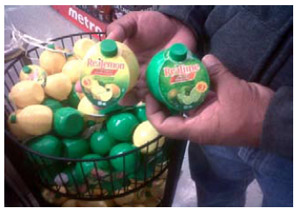
 The UWI, through the Department of Agricultural Economics and Extension, has embarked on an initiative to assist in the revitalization of the Trinidad and Tobago citrus industry. This project seeks, amongst others, to develop a new, sustainable agronomic model for the re-development of the Citrus Industry in Trinidad and Tobago; to increase opportunities for agri-entrepreneurs and to increase domestic food and nutrition security. The UWI, through the Department of Agricultural Economics and Extension, has embarked on an initiative to assist in the revitalization of the Trinidad and Tobago citrus industry. This project seeks, amongst others, to develop a new, sustainable agronomic model for the re-development of the Citrus Industry in Trinidad and Tobago; to increase opportunities for agri-entrepreneurs and to increase domestic food and nutrition security.
The project uses a demand-led approach where local farmers and processors can team up to get at least 25% of the $50 million frozen concentrated orange juice (FCOJ) import market and 50% of the apple and grapes market which has an import value of $25 million. The approach here is to increase fruit consumption across the youth population including through the School Nutrition Programme – to augment the health of the nation’s children; develop a campaign to increase consumption of citrus juices across the population and to increase competition to capture market share for local juices.
The project started with the nation’s school teachers since July 2012, encouraging them to simulate demand amongst school children.
Dr Govind Seepersad, Citrus RDI (Research Development Impact) Fund Project Team Leader reminded participants that no longer does the citrus business reside on selling fruits in recycled bags and boxes, placed in heaps and looking for buyers. The world has changed and the way business is conducted has changed. Suppliers must recognize that they have produced a great, healthy, nutritious product, one which buyers are willing to pay good prices if presented properly.
New marketing strategies are being developed to simulate demand. This includes highlighting the health benefits as a major driver to simulate demand.
Entrepreneurs are not to limit themselves by fresh fruit and juices alone. The project also highlighted emerging global trends such as new uses for lemon oil.
On the juice side, they are looking at a new acidulant application of lemon juice on fruit juices and derivatives with acid deficiencies. Lemon juice is also being used as a preservative for baby foods and lime lends itself easily to industrialization.
In the developing countries we found a range of new products. The trend of large companies is that of serving the food and beverage industry with the “freshest best quality citrus flavours and products”. Companies are now using words such as: “From the Named Fruit” citrus flavours “designed to enhance the overall flavour profile” of your juices, fruit juice drinks or confectionery products. They have recognized that successful flavours provide the cornerstone of a quality brand by building into the juice product: “a true and motivating difference in kind”.
Marketing trends are using citrus as a specialty product. Integrating proven flavoring components creates a synergistic result, providing “a beverage with a distinctive and exclusive profile.”
Also, they are highlighting: “Flavour is more than Taste”. Flavours provide an “emotion to the senses”, and “flavouring preferences are unique for each customer”.
Even packaging and presentation have changed, making the products more user-friendly and attractive. Thus, local producers have a range of option and creativity to choose, from simple to innovative packaging to that of fresh juice and retail-sized concentrate packets.
Thus, as we try to re-engineer the local citrus industry, can the second mouse get the cheese? We think they can.
Govind Seepersad (Phd) is the Citrus RDI Fund Project Team Leader, Department of Agricultural Economics and Extension, UWI, St Augustine. This was his presentation at the launch of “The National Citrus Project” in December 2012. The UWI-led team will work with the Ministry of Food Production, Land and Marine Resources and other stakeholders to supply the country’s fresh citrus-table fruits and the freshly squeezed juice market needs. |





